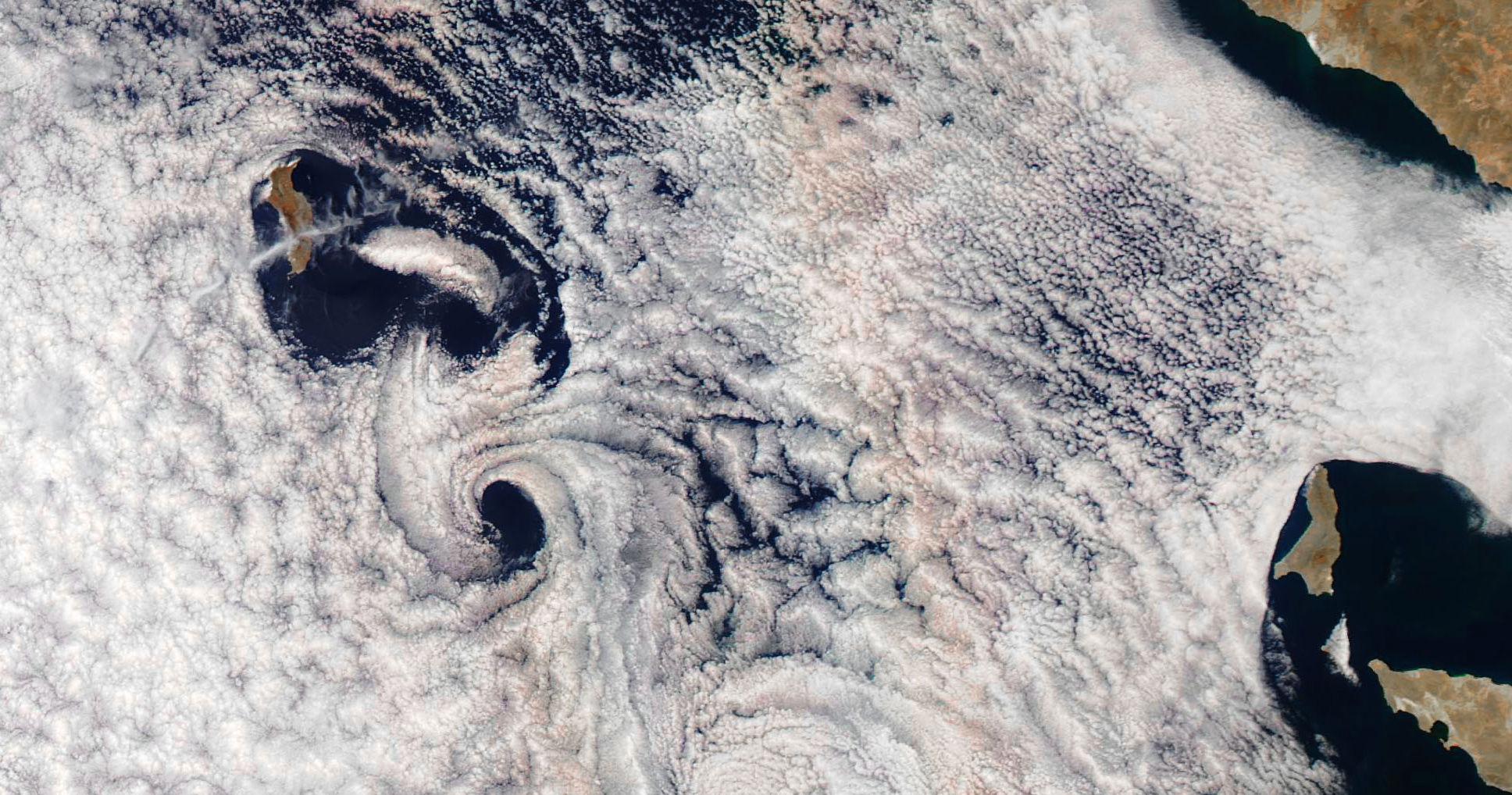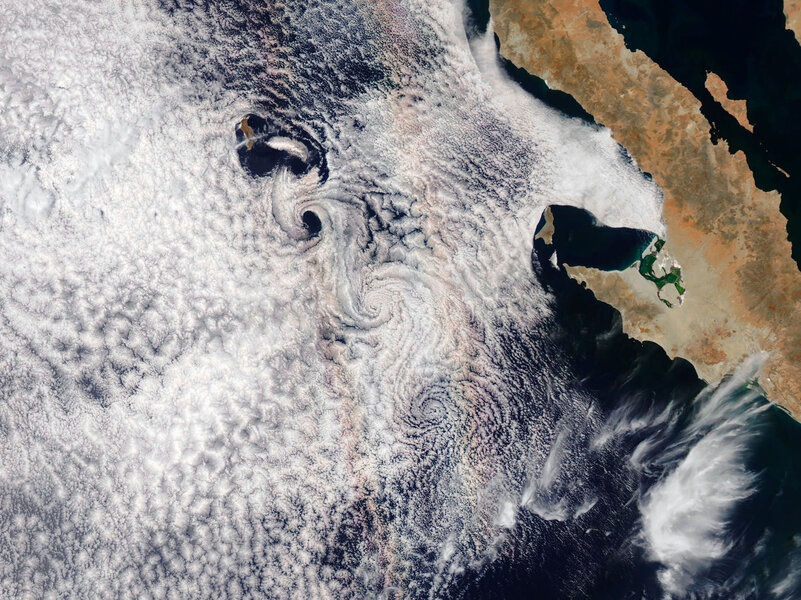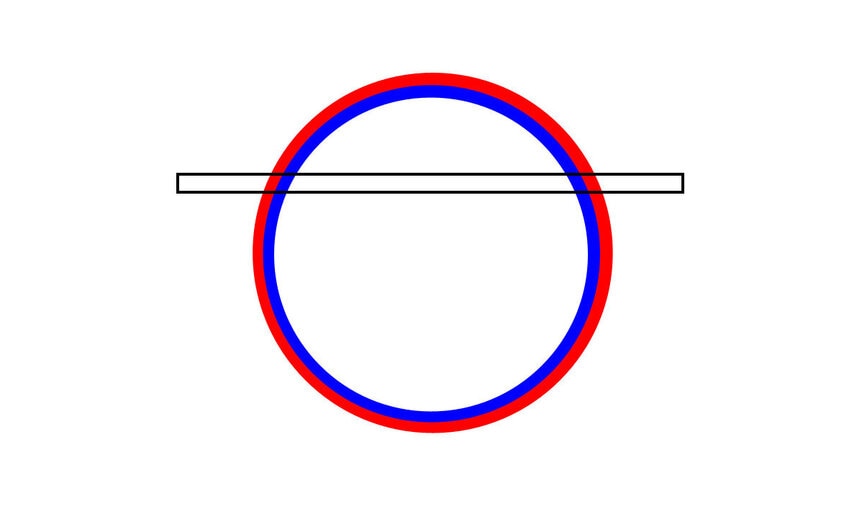Create a free profile to get unlimited access to exclusive videos, sweepstakes, and more!
A glorious vortex

I have a very weird image to show you today. It involves fluid dynamics, geometric optical effects, and the weird way that, sometimes, satellite imagery is created.
Guadalupe Island is a volcanic island a couple of hundred kilometers off the northwest coast of the Baja California peninsula. On June 3, 2018, the Aqua Earth-observing satellite flew over this part of the world and captured a truly odd and lovely image of it:
There are two things to notice here: One is the swirl of clouds flowing away from the island to the southeast (north is up in the image), and the other is the two bands of parallel reddish light aligned in roughly the same direction.
The alignment of the clouds and the streaks of light is coincidental. I know that because one is due to the wind direction, and the other is due to the satellite's direction of motion! This is really interesting, and a tad complicated, so let's dive in.
The swirls of clouds have the totally cool name of von Kármán vortices. When you get a chain of them it's a called a von Kármán vortex street. I've written about them many, many times, because I just love them. As I wrote before:
Imagine you have a cylinder (a pencil, or a bucket, or a concrete pylon) that you place in flowing water. It's an obstacle, and the water will flow around it.
However, near the cylinder's surface the water slows, piling up a bit. The water farther from the cylinder is moving faster. This causes eddies (vortices) to form, curls in the water. This kind of motion is a bit unstable, and can cause a slight force, pushing the water perpendicular to the direction of flow. But the water all around the flow pushes back, causing a sort of oscillation, like a pendulum swinging. The result is a series of vortices forming and flowing downstream, one on each side of the obstruction, alternating in pattern.
This is also called vortex shedding, another completely awesome term.
Guadalupe's peak sticks out of the water up to about 1,300 meters, so as the winds moving south blow past it they move around it. This creates eddies in the wind, which turn into little vortices, and as the air whips back and forth downstream like a tadpole's tail these vortices shed off, creating a line of them. Here's an animation showing how this works:
See? The flow starts off stable but inevitably becomes unstable, and you get that wiggle. The wiggle itself is somewhat stable, shedding off one vortex after another. Note the scale, though: Guadalupe is 20 kilometers long! So this is a pretty big atmospheric effect.
OK, that's the swirls. But what about those colored stripes?
This part is particularly weird. Those lines are a glory, a rainbow-like optical effect caused by light getting bent through water droplets in the atmosphere. But it's been distorted by the way the satellite observes the Earth.
I've written about glories, too, and even took video of one when I was flying home from a trip a few years back.
It's not entirely clear how glories form in detail, but in general the light from the Sun gets bent as it passes through drops of water in the air and sent back toward the observer. Different wavelengths (which are what we see as colors) get bent by different amounts, so the light is broken up into colors like a rainbow. The end result is a complete circle made up of bands of color centered around the point in the sky opposite the Sun.
But that's not what we see in that Aqua image! There's no circle. What gives?
Well, that's the fun part. Although this looks like a single photo, it's not! As it moves over the Earth, Aqua takes an image of a long, narrow strip of the Earth's surface below it. (the long part of the rectangle is perpendicular to the direction of motion, like the head of a push broom you're using to sweep up detritus on the floor). These can then be (more or less) stacked row by row to create an image like the one above. So it's not a photo taken all at once, but a series of images taken one after the other, then added together into a mosaic. So, for example, the row of pixels at the top of the image was taken at a different time than the one just below it, and the one just below that.
Remember, the glory is a product of the angles between the Sun, the satellite, and the clouds below. As the satellite moves, the position of the glory below moves with it, across the face of the Earth! It's like a target, a bulls-eye, moving under the satellite along with it. That's why the glory doesn't appear as a circle, but as a straight line; as the satellite moves it sees the same geometric part of the glory circle in the same spot in its detector, but the landscape (well, seascape) of the Earth moves below it.
This is also why there are two straight colored lines: The horizontal slit representing each row of the mosaic crosses the glory twice, once on each side of the circle (see the schematic above). And the colors in each line are reversed, since they're from opposite sides of the glory's circle.
That's so cool! I love it when camera effects change the way we see things, even if sometimes it involves a little bit of head-scratching and digging to figure it out.
And to wrap all this up neatly in a bow, it turns out a few years ago I wrote about a glory seen off the coast of Guadalupe Island as the air whirled around it! That's a fun coincidence. But in that case the glory appears as a circle, because the photo really was a photo, taken by an astronaut on the International Space Station. That made the explanation somewhat simpler.
And it makes me think that while complexity doesn't always yield beauty, that's the way to bet when it comes to Nature and the way we observe it.
















